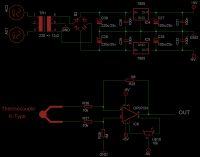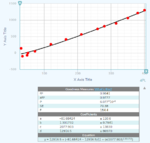abdoalghareeb
Member level 5

Thi is my design for interfacing K-Type Thermocouple with AVR microcontroller.

I use Differential Amplifier.
for measuring temperature I use good digital temperature meter.
The Temperature range is (0 == 1000 °C).
this is the table of result.
T (°C) <===> V (mille volt)
---------------------------------
31 <===> -141
35 <===> -100
49 <===> -70
51 <===> -3
72 <===> +51
120 <===> +265
165 <===> +412
211 <===> +565
260 <===> +731
280 <===> +813
315 <===> +900
350 <===> +1063
380 <===> +1215
400 <===> +1300
----------------------------------------------
My questions are:
Is there any wrong in this design?
How can I make all the output values positive (shift up 0°C == 0 volt)

I use Differential Amplifier.
for measuring temperature I use good digital temperature meter.
The Temperature range is (0 == 1000 °C).
this is the table of result.
T (°C) <===> V (mille volt)
---------------------------------
31 <===> -141
35 <===> -100
49 <===> -70
51 <===> -3
72 <===> +51
120 <===> +265
165 <===> +412
211 <===> +565
260 <===> +731
280 <===> +813
315 <===> +900
350 <===> +1063
380 <===> +1215
400 <===> +1300
----------------------------------------------
My questions are:
Is there any wrong in this design?
How can I make all the output values positive (shift up 0°C == 0 volt)






